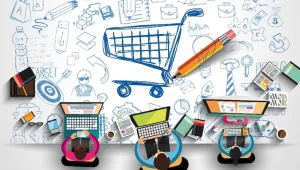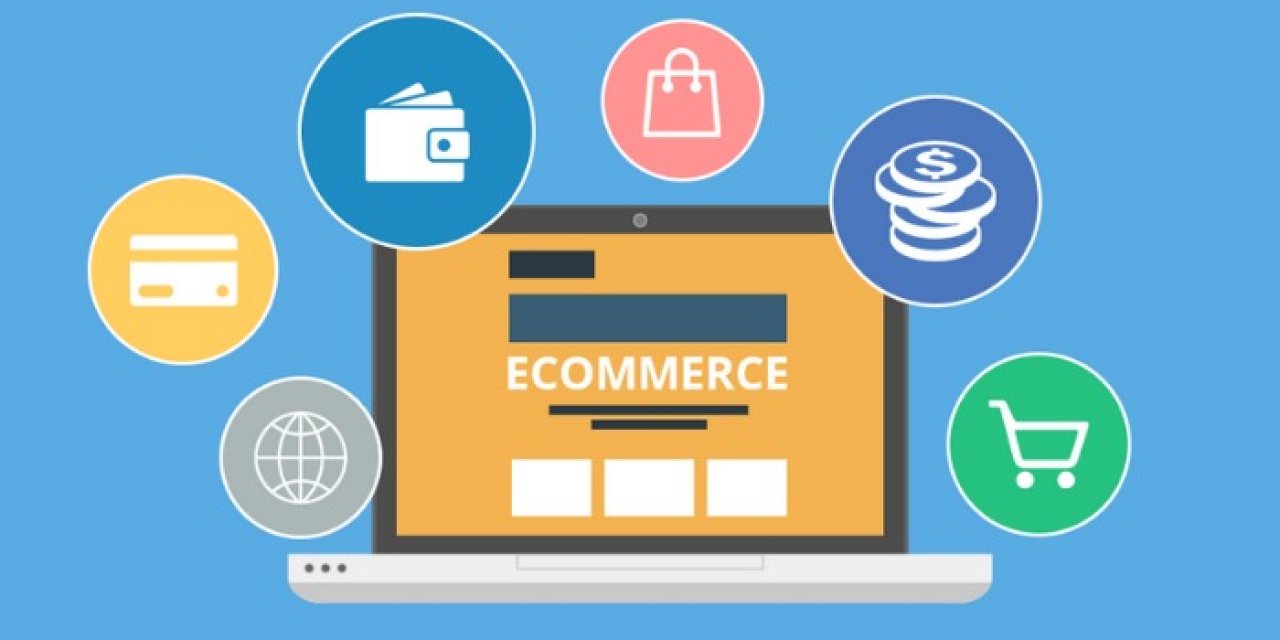E-commerce or electronic commerce is to buy and sell goods and services over an electronic network, especially the Internet, or to transmit funds or data. These commercial transactions take place in the form of enterprise (B2B), from enterprise to consumer (B2C), from consumer to consumer or consumer to enterprise. The terms e-commerce and e-Kuyruk are often used interchangeably. The term e-Kuyruk is sometimes used to refer to the processing processes that create online retail. In the last twenty years, the widespread use of e-commerce platforms such as Amazon and Ebay has contributed to a significant growth in online retail. According to the US Census Office, in 2011, e-commerce was 5 %of total retail sales. By 2020, with the start of the COVID-19 epidemic, it increased above 16 %of retail sales.
How e-commerce works is one of the important contents that this article discusses. E-commerce is supported by the Internet. Customers access an online store to browse and order products or services through their own devices. As the order is ordered, the customer’s web browser will communicate with the server with the e trade site. Order data will be forwarded to a central computer known as the order manager. It will then be transmitted to the databases that manage inventory levels. Using applications such as Paypal, a merchant system that manages payment information and a bank computer can be used for payment. Finally, it will return to the order manager. This is to make sure that the store inventory and customer funds are sufficient to process the order.
Once the order is approved, the order manager will notify the store’s web server. Images a message that indicates that the order is successfully processed. The order manager then sends the order data to the warehouse or the fulfillment department and informs that the product or service can be sent to the customer. At this point, concrete or digital products can be sent to a customer or access to a service. Platforms that contain e-commerce transactions include online marketplaces where vendors such as Amazon registered; Open source tools managed by software tools or companies by using in -house developers as a service that allows customers to rent their online store infrastructures can be listed.

Some different types of e-commerce are available. Some of the most common ones are included in this article. Between enterprises (B2B) refers to the exchange of electronic products, services or information among enterprises instead of e-commerce, enterprises and consumers. The examples include online directors and product and supply shopping websites that allow businesses to search for products, services and information and start transactions through e-sale purchase interfaces. A Forrester Report published in 2018 predicted that B2B e-commerce would reach $ 1.8 trillion by 2023 and will constitute 17 %of US B2B sales.
From enterprise to consumer (B2C), the retail part of e-commerce on the internet. It is to sell products, services or information directly to consumers. The term was popular during the explosion of Coming at the end of the 1990s, where online retailers and goods vendors were an innovation. Today, there are numerous virtual stores and shopping centers that sell all kinds of consumer goods on the internet. Amazon is the most known example of these sites. It is also the most dominant name of the B2C market.
From consumer to consumer (C2C), it is an e-commerce type where consumers exchange products, services and information online with each other. These operations are usually performed through a third party providing an online platform where transactions are performed. Online auctions and classified ads are two examples of C2C platforms. Ebay and Craigslist are two well -known examples of these platforms. Since ebay is a business, this type of e-commerce can also be called C2B2C and can be considered as consumer to enterprise, from consumer to consumer. Platforms such as Facebook marketplace and a fashion sales platform, such as depops, make C2C transactions possible.

From the consumer to the enterprise (C2B), it is an online type of e-commerce that consumers offer products and services online for companies to offer and purchase. This is the opposite of the traditional trade model of B2C. A popular example of the C2B platform is a market that sells design elements such as royalties, visuals, media and istock. Another example may be a business board.
From the enterprise to management (B2A), it refers to the online transactions between companies and public administration or government agencies. Many branches of the state are dependent on various types of e-service or product. These products and services are generally related to legal documents, records, social security, financial data and employment. Businesses can obtain them electronically. B2A services have increased significantly in recent years due to investments in e-government capabilities.
From the consumer to the administration (C2A), it refers to the online transactions between consumers and public administration or state institutions. The state rarely purchases products or services from individuals, but individuals often use electronic tools in the following areas:
- Social Security; Distributing and paying information.
- Taxes; Filling the tax returns and paying payments.
- Health; To make an appointment, give information about the test results and health status and make health care payments.
Mobile e-commerce (M-commerce) refers to online sales processing using mobile devices such as smartphones and tablets. It includes mobile shopping, banking and payments. Mobile chat bots allow M-commerce to complete consumers through voice or written conversations.

In addition to what e-commerce is and how the process is walking, the advantages and disadvantages of e-commerce must be taken into consideration. The benefits of e-commerce include 24-hour usability, access speed, wide availability of goods and services, easy accessibility and international access.
Usability is one of the most important features of e-commerce. In addition to interruptions and planned maintenance, e-commerce sites are open 24/7 and allow visitors to browse and shop at any time. Businesses operating in the real space are usually opened at certain times and can even be completely closed on certain days.
Access rate is another advantage. While shoppers in a physical store can slow down due to the crowd, e-commerce sites work quickly. This is determined by the information process and bandwidth on both the consumer device and the e-commerce site. Product and shopping basket pages are installed in a few seconds or less time. An e-commerce process may consist of several clicks and may take less than five minutes.
Wide usability is the most important advantage. Amazon’s first slogan was “the largest bookstore in the world.” Since it was an e-commerce site, not a physical store that had to stock every book on its shelves. E-commerce allows brands to offer a wide range of products that are shipped from a warehouse or various warehouses after the purchase of brands. Customers will probably be more successful in finding what they want.

Easy accessibility is another advantage. Customers who shop from a physical store may have difficulty finding a certain product. Website visitors can take a real -time look at the product category pages and use the site’s search feature to find the product immediately. International access can also be considered an advantage in this regard. Businesses operating in the real place sell to customers who visit their stores physically. With e-commerce, businesses can sell to anyone who can access the web. E-commerce has the potential to expand the customer base of an enterprise.
E-commerce requires less cost. Pure game e-commerce enterprises avoid physical store operating costs such as rent, stock and cashier. However, they can cause shipping and storage costs. Personalization and product recommendations are frequently encountered on e-commerce sites. E-commerce sites can monitor a visitor’s browsing, search and purchase history. They can use these data to provide personalized product suggestions and learn about target markets. The perceived disadvantages of e-commerce include sometimes limited customer service, the inability of consumers before purchasing or not touching or not touching and waiting time for the transportation of the product.
 Some different types of e-commerce are available. Some of the most common ones are included in this article. Between enterprises (B2B) refers to the exchange of electronic products, services or information among enterprises instead of e-commerce, enterprises and consumers. The examples include online directors and product and supply shopping websites that allow businesses to search for products, services and information and start transactions through e-sale purchase interfaces. A Forrester Report published in 2018 predicted that B2B e-commerce would reach $ 1.8 trillion by 2023 and will constitute 17 %of US B2B sales.
From enterprise to consumer (B2C), the retail part of e-commerce on the internet. It is to sell products, services or information directly to consumers. The term was popular during the explosion of Coming at the end of the 1990s, where online retailers and goods vendors were an innovation. Today, there are numerous virtual stores and shopping centers that sell all kinds of consumer goods on the internet. Amazon is the most known example of these sites. It is also the most dominant name of the B2C market.
From consumer to consumer (C2C), it is an e-commerce type where consumers exchange products, services and information online with each other. These operations are usually performed through a third party providing an online platform where transactions are performed. Online auctions and classified ads are two examples of C2C platforms. Ebay and Craigslist are two well -known examples of these platforms. Since ebay is a business, this type of e-commerce can also be called C2B2C and can be considered as consumer to enterprise, from consumer to consumer. Platforms such as Facebook marketplace and a fashion sales platform, such as depops, make C2C transactions possible.
Some different types of e-commerce are available. Some of the most common ones are included in this article. Between enterprises (B2B) refers to the exchange of electronic products, services or information among enterprises instead of e-commerce, enterprises and consumers. The examples include online directors and product and supply shopping websites that allow businesses to search for products, services and information and start transactions through e-sale purchase interfaces. A Forrester Report published in 2018 predicted that B2B e-commerce would reach $ 1.8 trillion by 2023 and will constitute 17 %of US B2B sales.
From enterprise to consumer (B2C), the retail part of e-commerce on the internet. It is to sell products, services or information directly to consumers. The term was popular during the explosion of Coming at the end of the 1990s, where online retailers and goods vendors were an innovation. Today, there are numerous virtual stores and shopping centers that sell all kinds of consumer goods on the internet. Amazon is the most known example of these sites. It is also the most dominant name of the B2C market.
From consumer to consumer (C2C), it is an e-commerce type where consumers exchange products, services and information online with each other. These operations are usually performed through a third party providing an online platform where transactions are performed. Online auctions and classified ads are two examples of C2C platforms. Ebay and Craigslist are two well -known examples of these platforms. Since ebay is a business, this type of e-commerce can also be called C2B2C and can be considered as consumer to enterprise, from consumer to consumer. Platforms such as Facebook marketplace and a fashion sales platform, such as depops, make C2C transactions possible. From the consumer to the enterprise (C2B), it is an online type of e-commerce that consumers offer products and services online for companies to offer and purchase. This is the opposite of the traditional trade model of B2C. A popular example of the C2B platform is a market that sells design elements such as royalties, visuals, media and istock. Another example may be a business board.
From the enterprise to management (B2A), it refers to the online transactions between companies and public administration or government agencies. Many branches of the state are dependent on various types of e-service or product. These products and services are generally related to legal documents, records, social security, financial data and employment. Businesses can obtain them electronically. B2A services have increased significantly in recent years due to investments in e-government capabilities.
From the consumer to the administration (C2A), it refers to the online transactions between consumers and public administration or state institutions. The state rarely purchases products or services from individuals, but individuals often use electronic tools in the following areas:
From the consumer to the enterprise (C2B), it is an online type of e-commerce that consumers offer products and services online for companies to offer and purchase. This is the opposite of the traditional trade model of B2C. A popular example of the C2B platform is a market that sells design elements such as royalties, visuals, media and istock. Another example may be a business board.
From the enterprise to management (B2A), it refers to the online transactions between companies and public administration or government agencies. Many branches of the state are dependent on various types of e-service or product. These products and services are generally related to legal documents, records, social security, financial data and employment. Businesses can obtain them electronically. B2A services have increased significantly in recent years due to investments in e-government capabilities.
From the consumer to the administration (C2A), it refers to the online transactions between consumers and public administration or state institutions. The state rarely purchases products or services from individuals, but individuals often use electronic tools in the following areas:
 In addition to what e-commerce is and how the process is walking, the advantages and disadvantages of e-commerce must be taken into consideration. The benefits of e-commerce include 24-hour usability, access speed, wide availability of goods and services, easy accessibility and international access.
Usability is one of the most important features of e-commerce. In addition to interruptions and planned maintenance, e-commerce sites are open 24/7 and allow visitors to browse and shop at any time. Businesses operating in the real space are usually opened at certain times and can even be completely closed on certain days.
Access rate is another advantage. While shoppers in a physical store can slow down due to the crowd, e-commerce sites work quickly. This is determined by the information process and bandwidth on both the consumer device and the e-commerce site. Product and shopping basket pages are installed in a few seconds or less time. An e-commerce process may consist of several clicks and may take less than five minutes.
Wide usability is the most important advantage. Amazon’s first slogan was “the largest bookstore in the world.” Since it was an e-commerce site, not a physical store that had to stock every book on its shelves. E-commerce allows brands to offer a wide range of products that are shipped from a warehouse or various warehouses after the purchase of brands. Customers will probably be more successful in finding what they want.
In addition to what e-commerce is and how the process is walking, the advantages and disadvantages of e-commerce must be taken into consideration. The benefits of e-commerce include 24-hour usability, access speed, wide availability of goods and services, easy accessibility and international access.
Usability is one of the most important features of e-commerce. In addition to interruptions and planned maintenance, e-commerce sites are open 24/7 and allow visitors to browse and shop at any time. Businesses operating in the real space are usually opened at certain times and can even be completely closed on certain days.
Access rate is another advantage. While shoppers in a physical store can slow down due to the crowd, e-commerce sites work quickly. This is determined by the information process and bandwidth on both the consumer device and the e-commerce site. Product and shopping basket pages are installed in a few seconds or less time. An e-commerce process may consist of several clicks and may take less than five minutes.
Wide usability is the most important advantage. Amazon’s first slogan was “the largest bookstore in the world.” Since it was an e-commerce site, not a physical store that had to stock every book on its shelves. E-commerce allows brands to offer a wide range of products that are shipped from a warehouse or various warehouses after the purchase of brands. Customers will probably be more successful in finding what they want.
 Easy accessibility is another advantage. Customers who shop from a physical store may have difficulty finding a certain product. Website visitors can take a real -time look at the product category pages and use the site’s search feature to find the product immediately. International access can also be considered an advantage in this regard. Businesses operating in the real place sell to customers who visit their stores physically. With e-commerce, businesses can sell to anyone who can access the web. E-commerce has the potential to expand the customer base of an enterprise.
E-commerce requires less cost. Pure game e-commerce enterprises avoid physical store operating costs such as rent, stock and cashier. However, they can cause shipping and storage costs. Personalization and product recommendations are frequently encountered on e-commerce sites. E-commerce sites can monitor a visitor’s browsing, search and purchase history. They can use these data to provide personalized product suggestions and learn about target markets. The perceived disadvantages of e-commerce include sometimes limited customer service, the inability of consumers before purchasing or not touching or not touching and waiting time for the transportation of the product.
Easy accessibility is another advantage. Customers who shop from a physical store may have difficulty finding a certain product. Website visitors can take a real -time look at the product category pages and use the site’s search feature to find the product immediately. International access can also be considered an advantage in this regard. Businesses operating in the real place sell to customers who visit their stores physically. With e-commerce, businesses can sell to anyone who can access the web. E-commerce has the potential to expand the customer base of an enterprise.
E-commerce requires less cost. Pure game e-commerce enterprises avoid physical store operating costs such as rent, stock and cashier. However, they can cause shipping and storage costs. Personalization and product recommendations are frequently encountered on e-commerce sites. E-commerce sites can monitor a visitor’s browsing, search and purchase history. They can use these data to provide personalized product suggestions and learn about target markets. The perceived disadvantages of e-commerce include sometimes limited customer service, the inability of consumers before purchasing or not touching or not touching and waiting time for the transportation of the product. 



